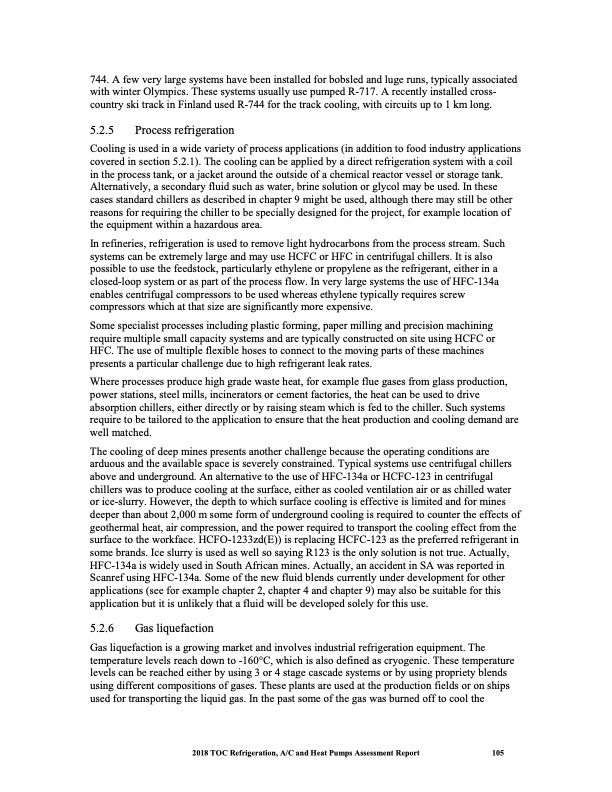
PDF Publication Title:
Text from PDF Page: 118
744. A few very large systems have been installed for bobsled and luge runs, typically associated with winter Olympics. These systems usually use pumped R-717. A recently installed cross- country ski track in Finland used R-744 for the track cooling, with circuits up to 1 km long. 5.2.5 Process refrigeration Cooling is used in a wide variety of process applications (in addition to food industry applications covered in section 5.2.1). The cooling can be applied by a direct refrigeration system with a coil in the process tank, or a jacket around the outside of a chemical reactor vessel or storage tank. Alternatively, a secondary fluid such as water, brine solution or glycol may be used. In these cases standard chillers as described in chapter 9 might be used, although there may still be other reasons for requiring the chiller to be specially designed for the project, for example location of the equipment within a hazardous area. In refineries, refrigeration is used to remove light hydrocarbons from the process stream. Such systems can be extremely large and may use HCFC or HFC in centrifugal chillers. It is also possible to use the feedstock, particularly ethylene or propylene as the refrigerant, either in a closed-loop system or as part of the process flow. In very large systems the use of HFC-134a enables centrifugal compressors to be used whereas ethylene typically requires screw compressors which at that size are significantly more expensive. Some specialist processes including plastic forming, paper milling and precision machining require multiple small capacity systems and are typically constructed on site using HCFC or HFC. The use of multiple flexible hoses to connect to the moving parts of these machines presents a particular challenge due to high refrigerant leak rates. Where processes produce high grade waste heat, for example flue gases from glass production, power stations, steel mills, incinerators or cement factories, the heat can be used to drive absorption chillers, either directly or by raising steam which is fed to the chiller. Such systems require to be tailored to the application to ensure that the heat production and cooling demand are well matched. The cooling of deep mines presents another challenge because the operating conditions are arduous and the available space is severely constrained. Typical systems use centrifugal chillers above and underground. An alternative to the use of HFC-134a or HCFC-123 in centrifugal chillers was to produce cooling at the surface, either as cooled ventilation air or as chilled water or ice-slurry. However, the depth to which surface cooling is effective is limited and for mines deeper than about 2,000 m some form of underground cooling is required to counter the effects of geothermal heat, air compression, and the power required to transport the cooling effect from the surface to the workface. HCFO-1233zd(E)) is replacing HCFC-123 as the preferred refrigerant in some brands. Ice slurry is used as well so saying R123 is the only solution is not true. Actually, HFC-134a is widely used in South African mines. Actually, an accident in SA was reported in Scanref using HFC-134a. Some of the new fluid blends currently under development for other applications (see for example chapter 2, chapter 4 and chapter 9) may also be suitable for this application but it is unlikely that a fluid will be developed solely for this use. 5.2.6 Gas liquefaction Gas liquefaction is a growing market and involves industrial refrigeration equipment. The temperature levels reach down to -160°C, which is also defined as cryogenic. These temperature levels can be reached either by using 3 or 4 stage cascade systems or by using propriety blends using different compositions of gases. These plants are used at the production fields or on ships used for transporting the liquid gas. In the past some of the gas was burned off to cool the 2018 TOC Refrigeration, A/C and Heat Pumps Assessment Report 105PDF Image | Heat Pumps Technical Options

PDF Search Title:
Heat Pumps Technical OptionsOriginal File Name Searched:
RTOC-assessment-report-2018_0.pdfDIY PDF Search: Google It | Yahoo | Bing
CO2 Organic Rankine Cycle Experimenter Platform The supercritical CO2 phase change system is both a heat pump and organic rankine cycle which can be used for those purposes and as a supercritical extractor for advanced subcritical and supercritical extraction technology. Uses include producing nanoparticles, precious metal CO2 extraction, lithium battery recycling, and other applications... More Info
Heat Pumps CO2 ORC Heat Pump System Platform More Info
| CONTACT TEL: 608-238-6001 Email: greg@infinityturbine.com | RSS | AMP |